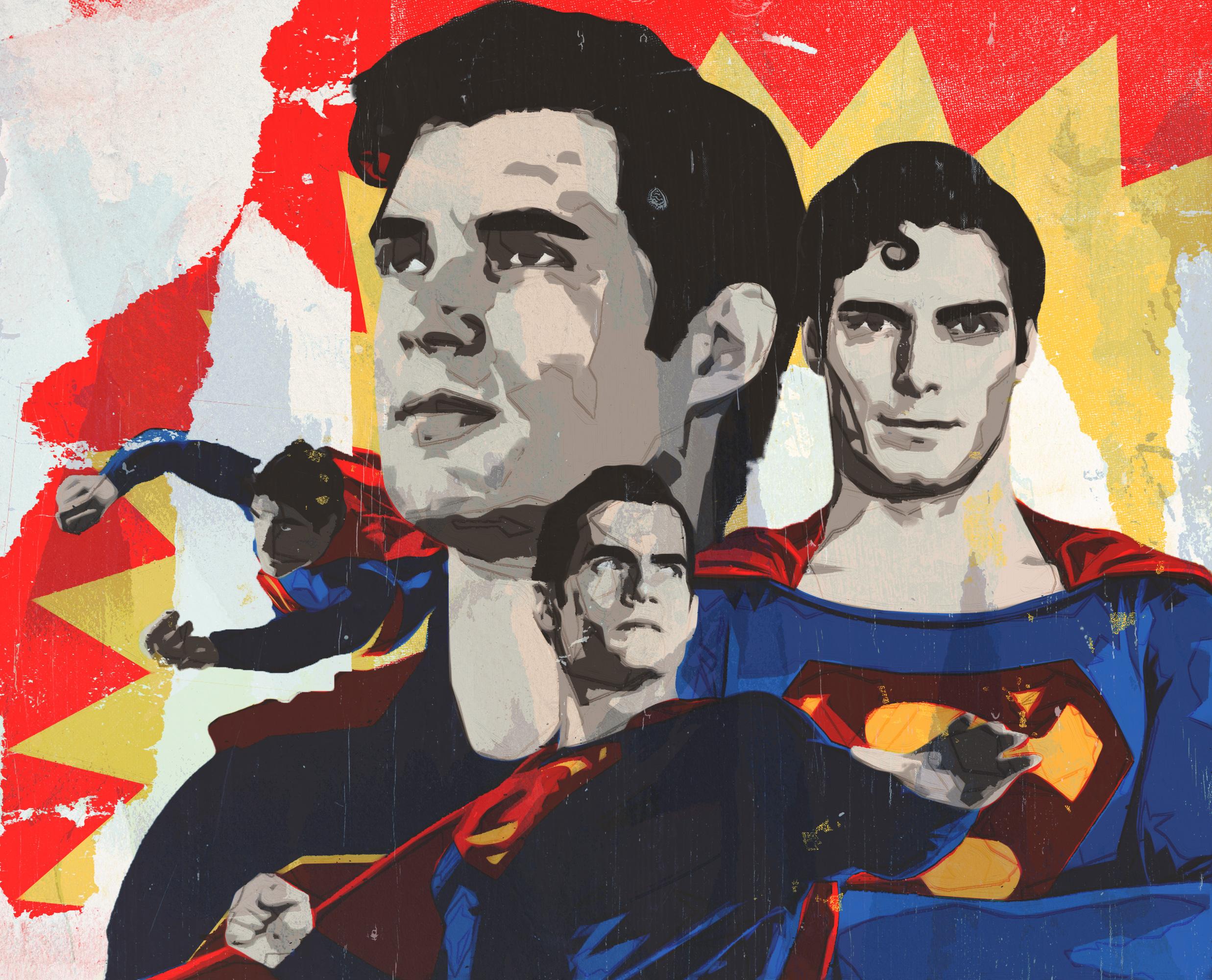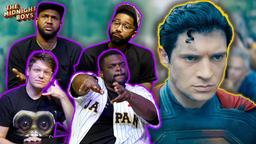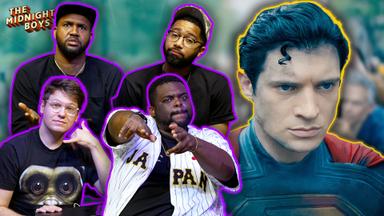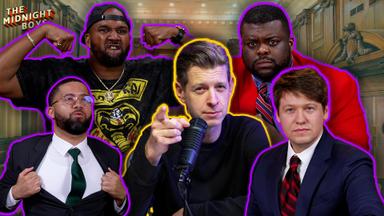Superman Is the Hero Every Era Needs
As DC’s latest reboot arrives, we talk to some of Superman’s writers to find out what makes him the most malleable superheroWhen you read the word “superhero,” who’s the first character you think of?
Does the image of Batman, preying on Gotham’s criminal underworld in the middle of night, come to mind? Is it Spider-Man swinging on his webs across New York City? Or could it be Wonder Woman, deflecting bullets with her indestructible bracelets and wrangling bad guys with her Lasso of Truth?
Chances are, Superman—with his blue tights and red cape flowing in the wind—was one of the first figures who surfaced. There’s a good reason for that.
“Superman is the first: He’s the template from which all the other superheroes were descended,” award-winning comic book writer Grant Morrison, who’s authored multiple Superman series, tells The Ringer. “Even Batman was created by being the opposite of Superman. Let’s take a character who works in the daytime and turn him into one who works in the night. Let’s change the bright red and blue to a gray and black scale. Everything was kind of influenced by Superman in one way or another. He’s one of those characters that everyone recognizes. Even if you weren’t into comics, even if you weren’t into superhero stuff, everyone knows Superman.”
Superman was created by Jerry Siegel and Joe Shuster in April 1938. Forty years later, Christopher Reeve soared into theaters as the Man of Steel in Richard Donner’s Superman, as the 1978 film fittingly became the first superhero blockbuster. With its triumphant theme composed by John Williams, and groundbreaking visual effects that brought the iconic character to life on the big screen, Superman unlocked the imaginations of moviegoers, just as the Kryptonian had for readers when he was introduced in the comic books decades earlier.
Today, superheroes are ubiquitous in popular culture. They’ve long transcended the limitations of the comics from which they were born, leaping from the page to radio shows, TV screens, movie theaters, video games, and even podcasts. In the 87 years since Superman’s debut, superhero storytelling has gone in and out of fashion, time and time again. And in the 21st century, these costumed luminaries have reached the peak of their mainstream success: Fifteen of the top 40 highest-grossing films of all time are now superhero movies.
But this latest, greatest commercial upswing for superheroes might once again be reversing itself. The DC Extended Universe faltered in the 2010s and early 2020s, and the chokehold Marvel Studios had on Hollywood during its wildly successful Infinity Saga has loosened. Superhero fatigue has become a tiresome topic—less a subject of speculation than an inescapable truth of the pop-culture landscape, as the oversaturation of stories centered on costumed vigilantes yields diminishing returns for major studios across film and TV.
This week, DC Studios relaunches its new cinematic era with its most important release in more than a decade: Superman. Writer/director James Gunn, who doubles as the co-CEO of DC Studios, has chosen to call on the company’s foundational superhero—and return to the roots of the genre at large—to reinvigorate the Warner Bros. Discovery subsidiary at a crucial juncture. The filmmaker now aims to recapture the movie magic that Donner tapped into, as Gunn shifts away from the darker tone of the DCEU’s Snyderverse era to turn back the clock to a more hopeful, uplifting version of the character. Although this is just the dawn of the DCU, how Superman fares with audiences could position the new venture for lasting success, or doom its future just as it’s getting underway.
As fitting as it is to turn to Superman to lead the retooled studio into what could be the start of a decade-long interconnected narrative that Warner Bros. hopes will rival the past success of Marvel Studios, it’s hard not to wonder whether the prototypical superhero will be able to emerge from an overcrowded field of crimefighters who have sprung from his image. Will the story of Superman still resonate with audiences in 2025? And will they still want to see yet another reimagining of a character who has been omnipresent for so long?
Ahead of one of the most anticipated films of the summer, I spoke to a number of creators—across comics, TV, and film—who have faced such questions about this character across different eras and mediums. I wanted to hear their thoughts on how Superman has been able to withstand the test of time, even as the industries he helped build have been in crisis. Whether these creators’ individual projects succeeded or not, they all refashioned Superman’s portrayal and altered his legacy before passing on his story for the next generation to tell in a way that suited the conditions of the day.
But can the Man of Steel—and the latest line of Superman storytellers—save DC, and superhero media, once more?
Over the years, 11 different actors have played the part of Superman in live-action TV or film projects—including the latest to take up the mantle, David Corenswet, in Gunn’s Superman reboot. More than a dozen voice actors have performed the coveted role of the Last Son of Krypton across animation, video games, and radio shows, while a legion of artists have illustrated the superhero within the pages of the many DC Comics stories that have featured him. And no matter who’s drawing him or bringing him to life on screen, Superman is—and always has been—a character who reflects the times.
Writer Jerry Siegel and artist Joe Shuster, both children of Jewish immigrants, came together at Glenville High School in Cleveland, Ohio, around 1932. Although they wouldn’t formally introduce Superman to the world until the publication of Action Comics no. 1 in 1938, his groundbreaking arrival had been in the works since soon after the two met.
“Superman was originally Jerry Siegel and Joe Shuster's response to their low socioeconomic circumstances in Cleveland, antisemitism, and [their] concerns about what was going on in the world,” explains Bob Greenberger, coauthor of Superman: The Definitive History.
In 1932, Siegel’s father—a tailor who owned a clothing store—was assaulted by a shoplifter and suffered a fatal heart attack as a result. Nine years later, Siegel’s mother died of a heart attack as well. “In a lot of ways, Superman was [Siegel’s] wish fulfillment for a better world because his life was not an easy one,” Greenberger says.
Drawing inspiration from mythic strongmen like Samson and Hercules, along with the fantastic heroes who starred in the period’s pulp magazines, Siegel dreamt up a new champion with superhuman abilities who could defend the oppressed and innocent. Shuster helped the writer visualize this character on the page, and the duo honed ideas that they had used in previous collaborations, including a 1933 story called “The Reign of the Superman” that they had published in their sci-fi fanzine, Science Fiction. By the time Action Comics no. 1 arrived in 1938, on the verge of World War II, there was a growing audience of readers who needed a hero—and a hopeful symbol—like Superman, too.
“He was wish fulfillment for readers who were dealing with the Great Depression in the ’30s, who were worried about their relatives in Europe with the rise of fascism,” Greenberger explains. “They needed something—someone—to step forward and fight the good fight that they couldn't.”
Even before the United States entered the war in 1941, Superman started to fight very real enemies overseas, as the character became the messenger for the creators’ urgent call for their nation to intervene in the global conflict. He would soon evolve into a tool for wartime propaganda, urging young Americans to enlist in the fight or contribute in other ways.
“In the 1930s, [Superman is] a radical socialist reformer fighting against the power,” Morrison says. “In the 1940s, of course, he joins the war effort and suddenly he's a patriot riding missiles, threatening countries.”
Superman’s popularity quickly grew beyond the scope of comic strips alone. During the conflict, the superhero regularly fought the likes of Nazi supervillains on the popular radio serial The Adventures of Superman. But after the war ended and the Nazis were defeated, the show’s writers realized that they needed to find a new villain for their star to fight every week. And so they turned their attention to another prominent group that was rooted in bigotry: the Ku Klux Klan.
In 1946, a human rights activist named Stetson Kennedy infiltrated the KKK with the hopes of exposing its secrets. He teamed up with the producers of the Superman radio serial to create a 16-episode story arc that saw the Man of Steel take on a thinly disguised stand-in for the Klan called the “Clan of the Fiery Cross.” Although the radio show met with some resistance from certain listeners who supported the KKK, its impact was extraordinary.
“There were calls for boycotts against their sponsors,” explains comic book writer Gene Luen Yang, who loosely adapted the radio serial in his award-winning 2020 limited series Superman Smashes the Klan. “There were even death threats that were sent to the writers’ room. But in the end, it was this tremendous success. By the time the final episode aired, the listenership of that radio show had grown. They won a bunch of awards for that specific story line. And, most importantly, the membership of the real-life Klan actually declined while that radio show was airing.”
The Adventures of Superman tore through the organization’s veil of secrecy and likely played a part in the downfall of the KKK’s public image. The story remains a remarkable instance of the fictional Superman not just intersecting with reality but transforming it, too.
The Man of Steel has been repurposed and reshaped across every era, as writers have used this malleable figure—and moral paragon—to address the leading social issues of the hour, or engage with emergent trends that readers, viewers, or listeners could relate to. When looking at the timeline of Superman’s various transformations in the comics throughout the 20th century, it’s easy to see much of American history and popular culture reflected in his evolution.
“In the ’50s, he’s like the men who come home from the war, and suddenly he’s got a family: He’s got a dog and a cat, and Supergirl, and all these relatives,” Morrison explains. “He’s a postwar family man trying to make sense of relatives. … In the ’60s, he becomes this cosmic seeker, and he starts to worry about pollution and [Native American] land rights problems. The comics became very relevant and based on headlines: How would Superman deal with overpopulation? How would Superman deal with the ecology?
“In the ’70s, he kind of flattened out,” Morrison continues. “In the ’80s, he became a yuppie. He was recreated, and suddenly Clark Kent’s handsome and sexy, and he’s not stumbling and bumbling anymore. In the ’90s, they had to kill him because he’d been around for so long, and they had to make an impression.”
These character changes were, of course, very intentional, and they often came as a direct result of DC Comics’ commercial needs to bolster sales in what became an increasingly competitive industry crammed with Superman’s many descendants. That’s partly why the creators of the iconic crossover event The Death of Superman, published from 1992 to 1993, made the shocking decision to (temporarily) kill the beloved superhero whom readers had taken for granted.
“As nefarious as it sounds, we reasoned that we needed to remind people of what Superman stands for, and why he will always matter as an inspiration—by taking him away from them,” The Death of Superman editor Mike Carlin wrote in the foreword to The Definitive History.
Sometimes, Superman is politically pointed; sometimes, he’s a cultural phenomenon. On other occasions, he’s a comforting source of escape in uncertain times. One such occasion occurred in the aftermath of the terrorist attacks on September 11, 2001, which preceded the premiere of the WB series Smallville by just one month.
During the summer leading up to the show’s release, Smallville creators Alfred Gough and Miles Millar didn’t know how viewers would respond to their forthcoming series. After all, Lois & Clark: The New Adventures of Superman had finished its 88-episode run only four years earlier, and this was long before the existence of the Marvel Cinematic Universe—or even Sam Raimi’s Spider-Man trilogy. Live-action superhero projects, especially those on TV, didn’t demand the level of attention from studios or audiences that they do today.
“It felt sort of frivolous and a lot of people were waiting to see what it was,” Gough says. “And then after 9/11, it was like, ‘Oh, America needs a hero.’ And Superman is that. The perception definitely switched. You can never predict those things, but [Smallville] just happened to be the right show at the right time.”
Smallville ran for 10 seasons, concluding its 218-episode journey in 2011 as the longest-running North American sci-fi series by episode count. And it might not have become such a huge hit if it hadn’t arrived in the wake of a tragedy, draped in American patriotism.
“The look and aesthetic of the show is very much all-American, a celebration of stars and stripes and small-town Americana, which was very deliberate,” Millar says. “There was definitely a feeling that America needs a hero and that this somehow fulfilled that. You felt good watching it. It felt good to have someone who was pure of heart and who’s going to fight for justice and the American way. All those things weirdly helped the show’s success.”
Superman has survived as such a prominent character in pop culture for so long in large part because of his adaptability. The broadness of his character, which has allowed him to assume so many powers and conform to any time period, may explain why he’s often dismissed as boring. But Morrison, for one, sees this as a source of strength.
“He’s the primal superhero,” Morrison says. “He’s the basic one that everyone gets and understands. And that gives you a great amount of power to draw on. The guy’s 80 years old as a character and there’s been a lot of stories and a lot of different ways to look at that character. And so there’s a real depth there, almost like a human personality. It’s got so many contradictions—and that’s what I find fascinating. He has that power of longevity.”
Morrison wrote All-Star Superman, the Eisner-award-winning series that was originally published from 2005 to 2008. Drawn by artist Frank Quitely, the 12-issue story was part of the short-lived All-Star imprint that gave free rein to some of the most popular and acclaimed writers and artists in the industry to tell stories centered on DC’s biggest characters, without being constrained by any previous or ongoing continuities. Morrison used that creative liberty to tell an epic, episodic tale of Superman performing 12 heroic feats before his imminent death.
“Let’s do it about the sun, about Superman as a solar character, almost a solar deity, a contemporary version of the sky god,” Morrison explains of the creative process. “That gave us the hook: We’ll tell the story of the classic hero’s journey, the journey of the sun going down into darkness during the night, the underworld, then rising back up again, and then being reborn. And so that gave us a mythical spine to start building the story from. And once I had that, I realized I could do really basic, primary-colored versions of all the stuff I loved most about Superman.”
Sifting through the character’s history and finding that hook is the key to telling a Superman story—or to any adaptation, particularly one that features a returning character. Thus, it’s a foundational element of the serialized world of superheroes, especially when it comes to heroes who have been around as long as Superman or Batman have.
“When you’re working with a character like Batman or Superman that has 80-plus years of stories, whether it be radio plays, video games, movies, or animated shows, there’s a lot to draw from,” says David S. Goyer, who wrote Man of Steel and cowrote Christopher Nolan’s Dark Knight trilogy. “And in the comic books, various retcons. And so, in terms of the mainstream audience, there’s not one Superman, or there’s not one Batman. People come to the character in different ways.”
Batman was created by Bob Kane and Bill Finger in 1939, just one year after Superman, as DC Comics sought to build on the success of his predecessor. Consequently, the Caped Crusader has a similarly vast number of incarnations across a multitude of mediums.
“When Chris [Nolan] and I were working with Batman, we developed this process we call Story Darwinism,” Goyer explains. “We would look at all these various iterations of the character that had come out over the years and we identified the elements that are sticky—that sort of appear again and again, or seem to have worked again and again. So when they’re rebooting the character 20 years later, why are they rebooting these certain things? And it’s because they have stood the test of time. These seem to be the core elements.”
With Superman, the basic plot points that tend to survive this evolutionary process begin with a boy being sent to Earth from a dying alien planet and landing in Smallville, Kansas, where he’s adopted by loving parents who raise him to use his extraordinary powers for the good of humankind. The list of Superman essentials extends to the double life he leads as the innocuous Daily Planet journalist Clark Kent, his relationship with Lois Lane, and his aversion to kryptonite. But beyond identifying which core elements work, and which pitfalls to avoid, the challenge becomes staking a claim to untouched or underdeveloped narrative territory pertaining to a character who’s been the central focus of so many different stories. And that’s a problem for creators in any medium.
The creators of Smallville had a wide array of live-action Superman stories from the preceding decades to consider and contend with. “The last iteration of Superman had been Lois and Clark,” Gough recalls. “If you think about it, it was Lois and Clark in the ’90s, The Adventures of Superboy—which is a syndicated show—in the ’80s, the Christopher Reeve movies, and the George Reeves TV show [in the ’50s]. For us, he’s an iconic character and we all love him, but you didn’t understand him as a human. And what we were able to do is kind of tell the untold chapter of his life.”
Smallville focused on Clark Kent’s formative years, repositioning his story around his life in high school and on the farm and tapping into the teenage angst of the late ’90s and early 2000s. “The show had two big ideas, which was: It’s puberty with superpowers, and it is a show about extreme parenting,” Gough explains. “So it’s like you had the Luthers and the Kents, and it was a case study in how both of these young men were raised.”
“It’s also the idea of literally grounding the character and the idea that he wouldn’t wear a costume,” Millar adds. “We were fighting this sense that there was a cheese factor at that point; that [superheroes had] the lowest-in-class cheeseball effect. So we just really wanted to make you feel the humanity of the character, the complexity of the character. That he wasn’t yet Superman, that the last moment of the show would be him putting on the costume and flying.”
More recently, another creative team has zeroed in on this early chapter in Superman’s life, while slightly shifting the timeline to an era in which Clark has left behind the farm but has yet to become the full-fledged superhero who’ll lead the Justice League. For the animated series My Adventures With Superman, which premiered on Adult Swim in 2023, showrunners Jake Wyatt, Brendan Clogher, and Josie Campbell went through a similar Darwinist process to home in on the version of Superman that they wanted to tell.
“You just go back, sometimes a decade or sometimes a lot more, and you find the take on the character that works for you,” Wyatt explains. “There are two advantages that we had. One was that we were in an era that had a certain take on Superman that was darker and grittier, and more grounded. And we knew we weren’t doing that, right? So it was really easy to hop back to the ’70s with Christopher Reeve, who was so hot and nice, and that formed our idea of Superman as this nice, handsome guy.”
Wyatt continues, “And then we had the context of action cartoons that had changed. We had Bruce Timm’s Superman. And honestly, they covered so much ground [in Superman: The Animated Series] that it really made it clear for us what was left, which was everything before Bruce Timm’s show.”
For Clogher, another key factor for My Adventures With Superman was also highlighting Lois Lane, who’s just beginning her illustrious career at the Daily Planet as the series starts.
“You don’t have Superman without Lois Lane,” Clogher says. “Because the core element of Superman’s story is a love story. It’s him finding his humanity through this woman that he loves and seeing her world as his world, and taking that on. And that’s, to me, the core ingredient of the character that marries Superman and Clark Kent together in our show in a way that I don’t think has really been done since the Donner films.”
These storytelling tactics have proved to be effective on a modest scale for a number of TV and comics creators in recent years. But retaining the attention of a global audience that’s increasingly stretched thin in the streaming era, all while DC attempts to build other superhero franchises around Superman, is a more daunting task—one that the studio has yet to solve.
While there have been plenty of successful Superman stories in various mediums in the 21st century, the archetypal superhero hasn’t had the same staying power that he had in movie theaters when Reeve held the mantle in the late ’70s and early ’80s.
Bryan Singer’s 2006 reboot, Superman Returns, starred Brandon Routh and served as a spiritual sequel to Superman and Superman II, complete with Lex Luthor as the main antagonist (with Kevin Spacey replacing Gene Hackman in the role). The film hewed too closely to the tone that Donner had established decades earlier, with a story that ran at a glacial pace for more than two and a half hours. Superman Returns earned $391 million at the global box office against a $270 million budget and never received a sequel.
Warners tried to refresh the blockbuster franchise again in 2013 with the Zack Snyder–directed Man of Steel, which featured Henry Cavill as the new Superman. By then, Marvel Studios had already propelled the MCU to new box-office heights with its 2012 crossover event, The Avengers. And Warners wanted to use its DC characters to get it on the action as quickly as possible.
“I had some concern at the time,” Goyer recalls. “DC/Warner Bros. had had tremendous success with The Dark Knight, and they were really anxious to create their version of the MCU. At one point, Warner Bros. announced this whole slate of movies that [it was] going to roll out over the next three to four years. Most of which they didn’t even have ideas for. And in various meetings, I kept saying the thing about the MCU is that it was built very deliberately. It was like Iron Man’s gonna come, and then Captain America, then Thor, and Iron Man 2, and then Avengers. And I kept saying, you just can’t go from zero to 60 like that. You have to build it carefully.”
What DC needed was its own version of Marvel Studios president Kevin Feige, someone who could assemble the company’s impressive roster of superheroes in an interconnected series of narratives governed by a clear, unified vision. And, according to Goyer, Warners wanted that person to be Christopher Nolan. “Chris was very vocal that he didn’t want to be the architect of the DC universe,” Goyer says. “He didn’t set out to do a Superman movie. It just so happened that I had an idea for Superman that I pitched him while we were working on Dark Knight Rises. And he said, ‘That’s really cool. I would produce that if you want.’ And I said, ‘Of course.’ So it kind of happened by accident.”
Instead of Nolan, DC secured Snyder as its leading filmmaker, who’d be tasked with establishing the creative vision and tone for the studio’s cinematic universe. But with input from Snyder, DC Entertainment creative chief Geoff Johns, and Warner Bros. co-production head Jon Berg, in addition to the financial demands that came from the top of Warners, the collective vision was anything but clear.
“Under Geoff Johns, Zack Snyder, and other people going back to the 2011 Green Lantern film, it was a hodgepodge of creators and creator visions,” Greenberger, the Superman historian, says. “And Warner Bros. kept putting creative executives in charge who may have had a passing familiarity with the properties, but really weren’t comic fans, or didn’t understand the DNA of a good superhero film.”
Warners didn’t have the kind of patience required to build a true competitor to the MCU, especially as Marvel entered the second phase of its Infinity Saga and showed no signs of slowing down.
“Originally, we were going to do a Man of Steel sequel and then there was this tremendous pressure,” Goyer explains. “There was going to be just a cameo of Bruce Wayne, not even Batman, in the sequel. And then Wonder Woman is in it too, and it suddenly became like, ‘Boom, here’s everything.’ On one hand that’s exciting and fun, but I was pushing to be a bit more deliberative and to really plan this out. I did feel a little bit like they were running before they walked. But I’m just one of the players in this massive corporate machine.”
That Man of Steel sequel never arrived. Instead, Superman fans were left with subsequent appearances by Cavill’s character in Batman v. Superman: Dawn of Justice (2016) and Justice League (2017), the latter of which ended any chance of the DCEU experiencing the sort of success that the MCU has mostly maintained since Iron Man premiered in 2008. Snyder, who after a family tragedy was replaced by Joss Whedon as the director of Justice League, never got to see his reported five-movie plan come to fruition—even though most of the DCEU films that followed his departure still exhibited the same gloomy visual sensibilities. Corporate dysfunction and IP mismanagement ultimately defined the DCEU era. The studio always had ambitious plans, but it lacked a well-conceived strategy to execute them.
Along the way, Superman’s big-screen presence got lost in the mix. For a time, it seemed as if Cavill might reprise his role as the Man of Steel after his surprise cameo at the end of 2022’s Black Adam, the film that was supposedly destined to change “the hierarchy of power in the DC Universe.” But Cavill’s return never panned out. However, that shift in power did occur—just not in the way that Dwayne “the Rock” Johnson had promised.
Several days after Black Adam was released in theaters in October 2022, Warners named Gunn and producer Peter Safran the co-chairs and co-CEOs of the newly formed DC Studios. When they unveiled their own ambitious plans the following January, which were notably “centralized under one creative vision,” the duo acknowledged the tumultuous state of affairs they were charged with repairing, and the pressure that they faced.
“We took a brand that was somewhat in chaos, and it’s an opportunity to build an extraordinary standalone studio with the best IP and stories in the world,” Safran said at the introductory press conference. “The opportunity to do that functionally from scratch and without limitations—the stakes are enormous.”
With Superman, Gunn is set to revive the franchise once again, with a new primary cast in familiar roles: Corenswet as Clark Kent/Superman, Rachel Brosnahan as Lois Lane, and Nicholas Hoult as Lex Luthor. At the same time, the writer-director is also bringing in a number of other DC superheroes—including Guy Gardner (Nathan Fillion), Hawkgirl (Isabela Merced), and Mister Terrific (Edi Gathegi)—to lean into the film’s comic book sensibilities. And then there’s the reintroduction of a certain superdog.
“You revise the hero to meet the times,” Goyer says. “And so our take with Man of Steel was a slightly more realistic, if you will, version of Superman. One of the things that’s happened is that it used to be, we’ll have 20 years or 30 years before we reboot a character. Now it seems like we reboot a character every six years. So that window has shortened.
“But we had a ‘more serious’ version of Superman and now we’re going back the other way,” Goyer continues. “It’s funny, I never would have dreamed of including Krypto in our version of Man of Steel, because it just didn’t make sense in a more grounded take on Superman. That being said, when I saw the first teaser for the new Superman and saw Krypto, me and my kids had a giant grin on our faces.”
Gunn could end up overstuffing his franchise opener with too many complementary superheroes, just as Dawn of Justice did in the DC Films era, or shift the tone too drastically, going from the darker take on the character to Gunn’s typical overtly silly feel. But Gunn is also bringing the superhero back to his roots in myriad ways. He’s concentrating on foundational elements of the character that feel like they fit the present, when anti-immigrant-and-refugee sentiment is spread from the White House and basic human rights are under siege.
“Superman is the story of America,” the director told The Times U.K. in a recent profile. “An immigrant that came from other places and populated the country, but for me it is mostly a story that says basic human kindness is a value and is something we have lost.”
Gunn’s comments have already been confronted with MAGA outrage and condemnation by talking heads on Fox News. But that immigrant aspect of Superman’s identity has always been central to who he is. It’s one of the primary themes that Yang focused on in Superman Smashes the Klan, because that dimension of the character was key to the shift in Yang’s previous perception of Superman as a “boring” superhero, which the writer had formed as a younger comics reader.
“If you look at his backstory, he is the most immigrant of immigrants,” Yang says. “He comes from a completely different culture and has to make his life here in America. One of the things he has to do just to get through his day is hide his true heritage. I thought about my parents, who I always thought of as boring and as rule followers, who are also immigrants. And I wondered if Superman was boring for the same reason my parents were boring. My parents want to follow rules because they don’t want anyone to question their citizenship. And maybe Superman is the same way. He knows deep down inside he’s this alien, he’s this foreigner, and he portrays himself as the perfect citizen so that no one will question his citizenship. Once I made that connection, my opinion of Superman flipped.”
Whether Superman is fighting for justice in the 1940s or in 2025, the Man of Steel’s message of hope—and as Gunn said, “basic human kindness”—is timeless. And the inherent, unwavering goodness that the superhero represents was a trait that attracted every one of the creators I spoke to. “Part of his appeal is just the morality, the simple morality of someone who will not let you down, even if it harms him,” Morrison says. “There are people like that, but they’re not like that all the time. But in fiction, we invented someone better than us.”
Over the next few days, and weeks, we’ll find out whether audiences are ready to embrace a new Superman and a fresh start for yet another superhero-centric cinematic universe. Early reviews from critics have been largely positive, yielding an 85 percent rating on Rotten Tomatoes. But no matter how the character’s latest incarnation fares, Superman will endure until the next reimagining.
“I’ve always said, he’s more real than I am,” Morrison says. “He was born in 1938 and he’s still only 28 or 30 years old. I was writing Superman stories when I was 28 and now I’m 65. I’ll be dead and Superman will still be 28 or 30, and someone else will be talking to someone like you about Superman.”












